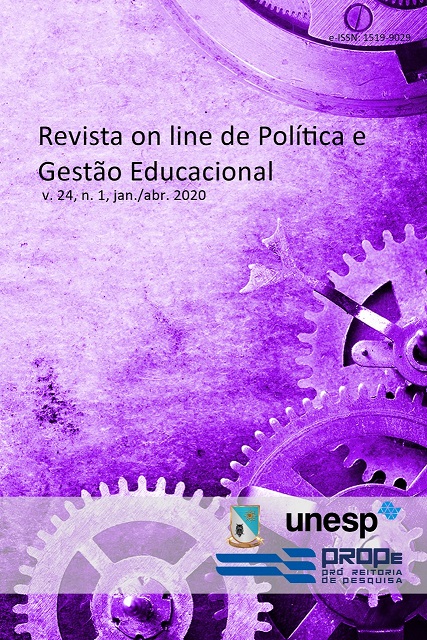Treatment of mutants as an allegory of the pathologization of subjects of non-intelligible genders: a reading from the x-men hq
DOI:
https://doi.org/10.22633/rpge.v24i1.13058Keywords:
Non-intelligible gender, Sexual education, Sexual diversity.Abstract
The characters of the comics have gained notoriety by transcending to the world of movies and television, especially the X-men. With great potential to reproduce perceptions and conceptions about the most different aspects of human life, the comics have served as a background for a reflection on social, cultural and moral issues. Having as a source of research the editions of 1 to 6 of the super gifted arc of the comics The incredible X-men, we will relate the pathology of the mutants of the comics as an allegory to the pathologization of sexual minorities, offering material for reflection and work for the respect to sexual diversity. Understanding the offer of the mutant cure as an allegory to the gay cure, we will reveal the underlying allegory in the condition of the characters in their fight against the pathologization of their mutant status, relating to the situation of the subjects of non-intelligible genders.Downloads
References
BEAZLEY, M.; YOUNGQUIST, J.; BRADY, M. Enciclopédia Marvel. São Paulo: Panini Comics, 2005.
BENTO, B. Na escola se aprende que a diferença faz a diferença. Rev. Estud. Fem., Florianópolis, v. 19, n. 2, ago., 2011.
BRAGA JR, A. X. Por uma sociologia da imagem desenhada: reprodução, estereótipo e actância nos quadrinhos de super-heróis da Marvel Comics. 2015. Tese (Doutorado em Sociologia) - Universidade Federal de Pernambuco, Recife, 2015.
BUTLER, J. Problemas de gênero. Feminismo e subversão da identidade. 14ª ed. Rio de Janeiro, Civilização Brasileira, 2017.
CAMPOS, J. X-men e a alegoria da luta dos direitos humanos dos negros e a “heroicidade” de Martin Luther King e Malcolm X. Revista Eletrônica da FEATI, v. 1, n. 12, p.190-194. Jan-jul., 2016.
CARDOSO JR, H. R. Foucault em voo rasante. In: CARVALHO, A. B. de; LIMA DA SILVA, W. C. (Orgs.). Sociologia e Educação: leituras e interpretações. São Paulo: Avercamp, 2006.
CEARÁ, A. T.; DALGALARRONDO, P. Transtornos mentais, qualidade de vida e identidade em homossexuais na maturidade e velhice. Rev. psiquiatr. clín., São Paulo: v. 37, n. 3, p. 118-123, 2010.
COENGA-OLIVEIRA, D. 'Se fosse normal, Deus teria criado Adão e Ivo!': a homofobia e a produção e regulação do sexo/gênero. 2011. 140 f. Dissertação (Mestrado) - Universidade de Brasília, Programa de Pós-graduação em Psicologia Social, do Trabalho e das Organizações, 2011.
DREYFUS, H.; RABINO, P. Em direção a uma teoria da prática discursiva. In: __________. Michel Foucault: uma trajetória filosófica. Rio de Janeiro: Forense Universitária, 1995.
EISNER, W. Quadrinhos e arte sequencial. São Paulo: Martins Fontes; 1989.
FOUCAULT, M. Microfísica do poder. Rio de Janeiro: Graal, 1979.
FOUCAULT, M. História da sexualidade I: A vontade de saber. Rio de Janeiro: Edições Graal, 1985.
FOUCAULT, M. O sujeito e o poder. In: DREYFUS, H. L.; RABINOW, P. Michel Foucault: uma trajetória filosófica. Rio de Janeiro: Forense Universitária, 1995.
FOUCAULT, M. Em defesa da sociedade: curso no Collège de France (1975-1976). (Trad. Maria Ermantina Galvão). São Paulo: Martins Fontes, 1999.
FOUCAULT, M. Poder e saber. In: MOTTA, M. B. (Org.) Estratégia, poder-saber. 2 ed. Rio de Janeiro: Forense Universitária, 2005.
FOUCAULT, M. A arqueologia do saber. (Trad. Luiz Felipe Baeta Neves). Rio de Janeiro: Forense Universitária, 2008.
HOPKINS, P. D. A Sedução do Normal: Quem não quer ser mutante? In: Irwin, W. (Org.). X-men e a filosofia: visão surpreendente e argumento fabuloso no X-universo mutante. (Trad. Marcos Malvezzi). São Paulo: Madras, 2009.
ILEA, R. A cura mutante ou mudança social: Debatendo a deficiência. In: Irwin, W. (Org.). X-men e a filosofia: visão surpreendente e argumento fabuloso no X-universo mutante. (Trad. Marcos Malvezzi). São Paulo: Madras, 2009.
MARGONARI, D. M.; BRAGA JR, A. X. O humor das tiras em quadrinhos na educação para a diversidade sexual. Revista Ibero-americana de Estudos em Educação, v. 10, p. 1603-1621, 2015.
MOISÉS, M. Dicionário de termos literários. 12. Ed. São Paulo: Cultrix, 2004.
ORGANIZAÇÃO MUNDIAL DE SAÚDE. Classificação de transtornos mentais e de comportamento da CID-10: descrições clínicas e diretrizes diagnosticas. Porto Alegre: Artmed, 1993.
PORCHAT, P. Psicanálise e Transexualismo: Desconstruindo gêneros e patologias com Judith Butler. Curitiba: Juruá, 2014.
PRADO, M. A. M.; MACHADO, F. V. Preconceito Contra Homossexualidades: A Hierarquia da Invisibilidade. 2. ed. São Paulo: Cortez, 2012.
PRINS, B.; MEIJER, I. C. Como os corpos se tornam matéria: entrevista com Judith Butler. Rev. Estud. Fem., Florianópolis, v. 10, n. 1, p. 155-167, jan., 2002.
RAMOS, P. A leitura dos quadrinhos. São Paulo: Contexto, 2010.
SALIH, S. Judith Butler e a teoria queer. São Paulo: Editora Autêntica, 2017.
ZENI, L. Por que usar quadrinhos em sala de aula? Nona Arte: Revista Brasileira de Pesquisas em Histórias em Quadrinhos, v. 3, p. 125-129, 2014.
WHEDOW, J.; CASSADAY, J. Surpreendentes. X-Men Volume 1 – Superdotados. Panini Comics, 2008.











